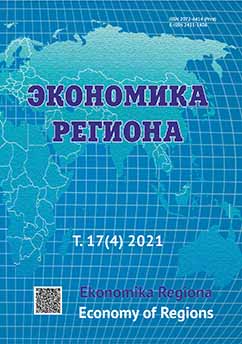Распространение пандемии COVID-19 в регионах России в 2020 году: модели и реальность
The Spread of the Covid-19 Pandemic in Russian Regions in 2020: Models and Reality
Author(s): Alexander Pilyasov, Nadezhda Zamyatina, Egor A. KotovSubject(s): Economy, Geography, Regional studies
Published by: Институт экономики Уральского отделения Российской академии наук
Keywords: Russian regions;Covid-19 pandemic; multivariate regression model «variables-excess mortality»; contact intensity of various industries and socio-cultural events; model «network-place-scaling»
Summary/Abstract: Considering the widespread of Covid-19 and its impact on the population health in Russian regions, it is necessary to examine the impact of the pandemic (as excess mortality) on the regional socio-economic development in 2020. Based on a quantitative and qualitative model, the study explains the process of coronavirus diffusion at the regional level, using information from foreign publications, Russian regional statistics and a database of legal documents «Consultant +». The concept of spatial diffusion, developed in the 1950s-1980s, was chosen as the research methodology. The study methods include a cartographic analysis of the monthly dynamics of coronavirus spread in Russian regions and regression analysis of regional differences in excess mortality regarding the most significant explanatory variables. The developed regression model explains the spread of Covid-19 across Russian regions in 2020, while the proposed qualitative model «network-place-scaling» describes the spatial diffusion of the virus. The conducted analysis confirmed the relationship between the spread of the virus and economic specialisation of regions. Simultaneously, such widely discussed factors as physical density, urbanisation level and per capita income did not show significant correlation with excess mortality. The study revealed the following results. There is a significant discrepancy between the actual situation in Russian regions and expected developments according to the simplified centre-periphery model. The important regression variables, explaining the interregional differences in excess mortality in 2020, include the share of employed in contact-intensive wholesale and retail trade and manufacturing (large production teams); proportion of the population over 65; the number of retail facilities per 1000 people. The qualitative model «network-place-scaling» was deemed suitable for explaining the mechanisms of the spread of coronavirus in Russian regions. Future studies should focus on examining the mechanisms and socio-economic consequences of the pandemic at the municipal level of large cities and urban agglomerations in Russia.
Journal: Экономика региона
- Issue Year: 17/2021
- Issue No: 4
- Page Range: 1079-1095
- Page Count: 17
- Language: Russian

